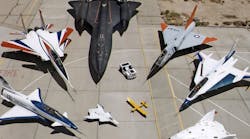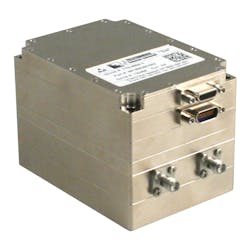Flight-test-instrumentation (FTI) equipment acquires flight avionics and aircraft structural and environmental parameter data for real-time monitoring during test flights and for offline analysis. Solutions for FTI include data-acquisition units (DAUs), recorders, switches, gateways, cameras, and RF transmitters and transceivers. FTI encoders and RF transmitters deliver real-time monitoring, while offline analysis involves analyzing data recorded during the test flights.
Designers of FTI equipment must meet unique environmental (physical and electromagnetic-interference, or EMI) and size, weight, and power (SWaP) requirements. In practice, the design of RF equipment for FTI applications is both a science and art, with expertise honed through experience and knowledge of flight test industry needs and practices.
Most FTI equipment installation occurs only during the test phase for airborne platforms; it must function without affecting the test platform dynamics and functional performance. In addition, FTI equipment is often installed in space-constrained locations without adequate airflow or cooling, which makes the operating environment more challenging. This puts a premium on compact equipment that draws very little prime power, and operates optimally in both high and low temperatures, as well as under severe shock, vibration, and humidity environments as specified by environmental standards like MIL-STD-810.
What’s more, one must consider EMI, both in how it might impact or be impacted by other aircraft equipment. FTI RF equipment must be designed to meet EMI requirements, as dictated by standards such as MIL-STD-461. The FTI RF equipment should have long mean time between failure (MTBF) and require very little field adjustment or maintenance. Finally, it’s preferable that FTI equipment be deployed as a line replaceable unit (LRU).
The RF solutions used in FTI telemetry (TM) applications include transmitters, transceivers, transponders, and receivers. In the U.S., the RF frequency bands for FTI transmitters, transceivers, transponders, and FTRs are specified by the Range Commanders Council (RCC).
RF transmitters handle real-time (downlink) transmission of flight test data, as well as mission and safety critical data, to a ground receiver station. The transceivers fulfill a similar role, except they offer bidirectional links (i.e., uplinks and downlinks) between the airborne test platform and the ground station. The bidirectional links enable the ground station to select or modify the list of test parameters that are transmitted on the down-link, during the test flight. Today, the transmitter RF frequency bands are in the L-, S-, and C-bands, with a planned migration to C-band in the near future for most U.S. test ranges. FTI transceivers operate at S- and C-band, with C-band operation being the most common in the U.S.
Modulation Modes
Most TM transmitters use constant envelope modulation schemes (e.g., SOQPSK) to allow the transmitter power amplifiers (PAs) to operate at close to saturation, thereby achieving high efficiency (low prime power draw) for a given RF output power. Many FTI customers prefer to program their transmitters to specific output powers (e.g., 1, 5, 10, or 20 W) for each flight or mission. This requires RF designers to use innovative biasing schemes to maintain the PA at close to saturation at each required output power level.
New modulation schemes are being introduced, including the use of low-density parity coding (LDPC) and space-time coding (STC), to overcome multipath interference and improve the RF link distance. Because the transmitter frequency tuning range is quite wide, the transmitter PA must maintain its output power and efficiency across the entire tuning range. Furthermore, it must keep the harmonics and spurious signals within specifications, especially in the GPS frequency bands.
FTI RF designers have to balance competing constraints, including:
- High output power
- High efficiency (low prime power draw)
- Wide frequency tuning range
- Low inter-modulations, harmonics, and spurious
- Wide operating temperature range (typically −40 to +85°C)
- Low SWaP
- Excellent thermal transfer to the surrounding environment
Many transmitter functional blocks (e.g., modulator, oscillators, and power supply) are based on commercially available standard silicon devices. The PAs, though, offer RF designers great flexibility in choosing device technologies and circuit architectures to address the key application requirements.
Recently, the availability of high-power gallium-nitride (GaN) devices that operate at high junction temperatures, using 28-V dc or higher bias voltages, has alleviated many design constraints. Because they can operate at 28 V dc and higher, meeting MIL-STD-704 requirements, GaN devices are particularly suitable for avionics equipment. Their use also eliminates the power-supply inefficiencies that result from reducing the prime power voltage to those required for silicon power devices.
The use of balanced or push-pull circuit architectures assist in broadband impedance matching or reducing second harmonics. RF designers use their expertise and experience to design bias circuits, some with a microcontroller and other programmed controls, which are able to maintain the high RF output power and high efficiency across the temperature and frequency ranges typical of FTI application requirements.
RF Transponders
Most RF transponders used in FTI operate in the C-band, while a few perform in the X-band. For tracking purposes, transponders function as RF beacons by responding to a pulsed query from a ground tracking radar with a known pulsed reply waveform. These RF transponders, for the most part, use very-high-power pulsed waveforms with very low duty cycles so that the PA can operate close to saturation.
RF transponders for FTI must support wide tuning ranges, fast rise and fall times, and minimal pulse droop—all the while keeping the inter-modulation frequencies under specified limits. In addition, the transponder must provide adequate charge storage to keep the bias voltage stable in order to achieve minimal pulse droop. To address EMI requirements, it’s imperative that the RF transponder power supply restrict in-rush current during the charging cycle.
Due to their high-power short-pulsed waveforms, RF transponders generate many harmonics. These harmonics must be filtered to ensure co-site interference issues don’t crop up, especially in the GPS frequency bands. The RF filters for these transponders must feature low passband insertion loss, steep roll-offs, and high stopband attenuation, all of which pose challenge when designing for SWaP optimization. Another RF filter design challenge is the need to provide a good impedance match in the stopband, so that the power amplifier doesn’t exhibit instability when operating across wide frequency and temperature ranges.
For the most part, telemetry receivers are used as ground support equipment, so they do not experience the same SWaP and environmental constraints as transmitters and transponders. The key to successful TM receiver design, as it is to all receiver designs, is a low noise figure, wide frequency tuning range, high sensitivity, and wide dynamic range. The FTI industry has leveraged receiver designs from other applications and has adapted them to demodulate the FTI modulation schemes. These receivers provide the telemetry data for ground recording, real-time mission and safety critical data display, and post-mission analysis.
An example of a recent FTI RF device is Curtiss-Wright’s TTS-9800-2 programmable tri-band multimode transmitter (see figure). The TTS-9800-2 supports transmission in L-band (all), S-band (all), and C-band (lower and middle), and delivers high RF power efficiency. It supports user-programmable multimode transmitter speeds. And its design simplifies RF band selection in the field for flight test applications.
Sridhar Kanamaluru is Chief Architect, Aerospace Instrumentation, at Curtiss-Wright Defense Solutions.

